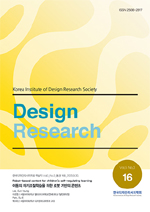
디지털휴먼의 평가지표에 관한 연구
A Study on the Evaluation Index of Digital Human: Focusing on emotional design and affordance design
- 한국디자인리서치학회
- 한국디자인리서치
- Vol8, No. 4(통권 29권)
- 2023.12
- 312 - 323 (12 pages)
제4차 산업 혁명 속에서 본 연구는 디지털 기술 중 디지털 휴먼 기술에 집중하고자 한다. 이 기술은 의료, 교육, 금융, 엔터테인먼트 등 여러 분야에서 성장했으나, 정보 보안, 취업 불안정, 디지털 격차와 같은 한계를 보이고 있다. 이에 따라 본 연구는 디지털 휴먼 서비스 분야에서 사용자의 감정 경험을 바탕으로 한 지속적인 혁신과 발전을 탐구하며, 감정적 인식을 기반으로 한 디자인 원칙에 대해 연구하는 것을 목표로 한다. 연구의 초점은 디지털 휴먼과 관련된 디자인 평가 지표에 대한 이해를 기반으로 탐색적 요인 분석, ANOVA 분석, 신뢰성 분석 등의 방법을 사용하였다. 이러한 방법을 통해 사용자 경험에 중대한 영향을 미치는 디자인 평가 지표를 식별하고, 이 지표들의 신뢰성과 안정성을 보장하고자 한다. 본 연구의 필요성은 디지털 휴먼 디자인에 중요한 참고 자료와 지침을 제공하여 디자이너가 사용자의 감정 및 실제 요구를 더 잘 충족시킬 수 있도록 돕는 데 있다. 또한, 연구 결과는 디지털 휴먼 감정 디자인의 사용성을 평가하는 데 기초를 제공하며, 이 분야에 있어 중요한 의미를 가진다. 본 연구를 통해 다양한 연령대 사용자의 요구와 선호도를 명확하게 이해하게 되었고, 그들이 디지털 휴먼 감정적 디자인에 대해 어떻게 반응하는지를 밝혀냈다. 특히 성인 사용자는 디지털 휴먼 감성적 디자인 측면에서 더 높은 기대와 요구를 가지고 있으며 직관성, 피드백, 일관성, 발견성, 유연성, 오류 허용 오차, 사용자 참여, 개인화 및 감정적 피드백, 스토리텔링 및 적응성에 더 많은 관심을 기울이고 있다. 이러한 측면에서 노인 사용자의 요구 사항은 상대적으로 낮다. 이것은 미래 디지털 휴먼 디자인의 방향을 정하는 데 중요한 통찰을 제공한다. 본 연구의 결과가 디지털 휴먼 디자인을 더 감정적인 방향으로 발전시켜 사용자 경험을 향상시키는 데 기여하기를 기대한다.
In the 4th industrial revolution, this study seeks to focus on digital human technology among digital technologies. This technology has grown in many fields such as medicine, education, finance, and entertainment, but it shows limitations such as information security, job instability, and digital divide. Accordingly, this study aims to explore continuous innovation and development based on users' emotional experiences in the field of digital human services and study design principles based on emotional recognition. The focus of the study was to use methods such as exploratory factor analysis, ANOVA analysis, and reliability analysis based on the understanding of design evaluation indicators related to digital humans. Through this method, we aim to identify design evaluation indicators that have a significant impact on user experience and ensure the reliability and stability of these indicators. The need for this study is to provide important references and guidelines for digital human design, helping designers better meet users' emotional and actual needs. Additionally, the research results provide a basis for evaluating the usability of digital human emotion design and have important implications for this field. Through this study, we gained a clear understanding of the needs and preferences of users of various age groups and revealed how they respond to digital human emotional design. In particular, adult users have higher expectations and demands in terms of digital human emotional design and pay more attention to intuitiveness, feedback, consistency, discoverability, flexibility, error tolerance, user engagement, personalization and emotional feedback, storytelling and adaptability. In this respect, the requirements of elderly users are relatively low. I'm leaning. This provides important insights for determining the direction of future digital human design. We hope that the results of this study will contribute to improving user experience by developing digital human design in a more emotional direction.
1. 서론
2. 이론적 배경
3. 감성적 디자인과 어포던스 디자인 평가요소 분석
4. 결론
참고문헌